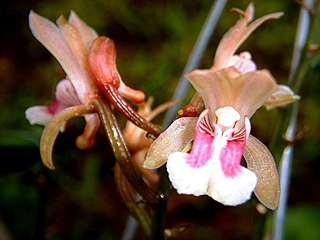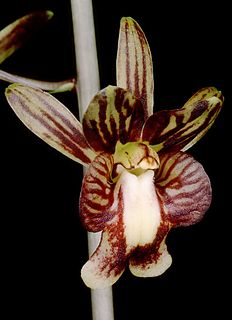
Oeceoclades maculata, sometimes known as the monk orchid or African spotted orchid, is a terrestrial orchid species in the genus Oeceoclades that is native to tropical Africa and now naturalized in South and Central America, the Caribbean, and Florida in North America. It was first described by the English botanist John Lindley as Angraecum maculatum in 1821 based on a specimen collected from South America. Lindley later revised his original placement and moved the species to the genus Oeceoclades in 1833.
Oeceoclades calcarata is a terrestrial orchid species in the genus Oeceoclades that is endemic to Madagascar. It was first described by the British botanist Robert Allen Rolfe in 1905 as Eulophia paniculata. The German botanist Rudolf Schlechter later described this species as Cymbidium calcaratum in 1915 and then transferred his own taxon to the genus Eulophia in 1925. When Leslie Andrew Garay and Peter Taylor revised the genus Oeceoclades in 1976, they transferred this species to the expanded Oeceoclades as O. calcarata because even though Eulophia paniculata was the older name and thus had priority, there had already been an earlier species named Oeceoclades paniculata that prevented using that specific epithet.
Oeceoclades ambongensis is a terrestrial orchid species in the genus Oeceoclades that is endemic to Madagascar. It was first described by the German botanist Rudolf Schlechter in 1913 as Eulophidium ambongense. When Leslie Andrew Garay and Peter Taylor revised the genus Oeceoclades in 1976, they transferred this species to the expanded Oeceoclades as O. ambongensis. Garay and Taylor noted that this species could be distinguished from closely allied species, such as O. maculata by its larger flowers with subglobose spur and a bilobed callus on the labellum.
Oeceoclades analavelensis is a terrestrial orchid species in the genus Oeceoclades that is endemic to southwestern Madagascar. It was first described by the French botanist Joseph Marie Henry Alfred Perrier de la Bâthie in 1939 as Lissochilus analavelensis. The English botanist V.S. Summerhayes later transferred this species to the genus Eulophidium in 1957. When Leslie Andrew Garay and Peter Taylor revised the genus Oeceoclades in 1976, they transferred this species to the expanded Oeceoclades.
Oeceoclades angustifolia is a terrestrial orchid species in the genus Oeceoclades that is endemic to southwestern and northern Madagascar. It was first described by the German botanist Karlheinz Senghas in 1966 as Eulophidium angustifolium. When Leslie Andrew Garay and Peter Taylor revised the genus Oeceoclades in 1976, they transferred this species to the expanded Oeceoclades. The type specimen was collected by Werner Rauh near the town of Sakaraha and the Fiherenana River.
Oeceoclades hebdingiana is a terrestrial orchid species in the genus Oeceoclades that is endemic to western Madagascar. It was first described by the French botanist André Guillaumin in 1964 as Lissochilus hebdingianus. It was then transferred to the genus Oeceoclades in 1976 by Leslie Andrew Garay and Peter Taylor. Garay and Taylor noted that this species is related to O. calcarata, but differs in the shape of the labellum. Oeceoclades calcarata also has a forward-projecting spur, while O. hebdingiana does not.
Oeceoclades lanceata is a terrestrial orchid species in the genus Oeceoclades that is endemic to central Madagascar. The flowers are rose-colored. It was first described by the French botanist Joseph Marie Henry Alfred Perrier de la Bâthie in 1935 as Eulophia lanceata. Perrier then later reduced the species to a synonym of Eulophia pandurata. The species was resurrected and transferred to the genus Oeceoclades in 1976 by Leslie Andrew Garay and Peter Taylor, who argued that O. lanceata and O. pandurata are distinct with regard to their floral structure and shape of the labellum. Garay and Taylor noted that O. lanceata is similar in vegetative morphology to O. seychellarum.
Oeceoclades latifolia is a terrestrial orchid species in the genus Oeceoclades that is endemic to São Tomé Island. It was first described by the British botanist Robert Allen Rolfe in 1891 as Eulophia latifolia, then moved to the genus Eulophidium by V.S. Summerhayes in 1957 and again moved to the genus Oeceoclades in 1976 by Leslie Andrew Garay and Peter Taylor. Garay and Taylor noted that O. latifolia is similar in vegetative morphology to O. atrovirens but the floral structure is more similar to O. ugandae. The lateral veins on the labellum are fringed with small hairs, a characteristic that is shared with O. pandurata, O. seychellarum, and O. lanceata.
Oeceoclades lubbersiana is a terrestrial orchid species in the genus Oeceoclades that is native to the Democratic Republic of the Congo and Uganda. It was first described by the Belgian botanists Émile Auguste Joseph De Wildeman and Émile Laurent in 1899 as Eulophia lubbersiana, then moved to the genus Eulophidium by V.S. Summerhayes in 1957 and again transferred to the genus Oeceoclades in 1976 by Leslie Andrew Garay and Peter Taylor. Garay and Taylor noted that this species is similar to O. atrovirens in vegetative morphology, but is better allied to O. latifolia and O. pandurata because all three possess a labellum that is wider than it is long. Oeceoclades lubbersiana was named in honor of Louis Lubbers, who was a botanist working at the Botanical Garden of Brussels.
Oeceoclades seychellarum is a terrestrial orchid species in the genus Oeceoclades that was endemic to the island of Mahé in the Seychelles but is now considered to be extinct. Its sepals and petals are yellowish-white, while the labellum is white with some streaks. This species is only represented by the type specimen, collected in May 1902 from the Cascade Estate on the island of Mahé at an elevation of 900 feet (270 m) in what was then a mountain forest. The location from which the type specimen was collected is now degraded by human activity and invasive plants. Oeceoclades seychellarum was listed as being cultivated at the Royal Botanic Gardens, Kew in 1905, but not after that date.
Oeceoclades pandurata is a terrestrial and epiphytic orchid species in the genus Oeceoclades that is native to eastern Zimbabwe and Madagascar. It was first described by the British botanist Robert Allen Rolfe in 1891 as Eulophia pandurata, then moved to the genus Lissochilus by Joseph Marie Henry Alfred Perrier de la Bâthie in 1941, and again moved to the genus Eulophidium by V.S. Summerhayes in 1957. It was finally transferred to the genus Oeceoclades in 1976 by Leslie Andrew Garay and Peter Taylor. Garay and Taylor noted that this species possesses lateral veins on the labellum that fringed with small hairs. Oeceoclades pandurata is distinguishable from other species in the genus by the lateral lobes of the labellum, which are free and truncate. The type specimen was collected on trees near Fort Dauphin on Madagascar, now known as the city of Tôlanaro. The specific epithet pandurata refers to the fiddle-shaped labellum.
Oeceoclades petiolata is a terrestrial orchid species in the genus Oeceoclades that is endemic to northern and western Madagascar. It was first described by the German botanist Rudolf Schlechter in 1913 as Eulophia petiolata. Schlechter later moved this species to the genus Eulophidium in 1925. It was again moved to the genus Lissochilus by the French botanist Joseph Marie Henry Alfred Perrier de la Bâthie in 1941 and last transferred the genus Oeceoclades in 1976 by Leslie Andrew Garay and Peter Taylor. Garay and Taylor noted that this species is almost identical to O. alismatophylla in vegetative morphology, but the two differ in the shape of the labellum on the flower. The labellum is fiddle-shaped and has three thickened veins in front of the calli.
Oeceoclades quadriloba is a terrestrial orchid species in the genus Oeceoclades that is native to Swaziland, southern Zimbabwe, and western Madagascar. It was first described by the German botanist Rudolf Schlechter in 1913 as Eulophia quadriloba. Schlechter later moved this species to the genus Eulophidium in 1925. It was again moved to the genus Lissochilus by the French botanist Joseph Marie Henry Alfred Perrier de la Bâthie in 1941 and last transferred the genus Oeceoclades in 1976 by Leslie Andrew Garay and Peter Taylor. Garay and Taylor noted that structure of the labellum is unique in the genus and resembles that of an Asian genus of orchids, Grosourdya. The spur is longer than the midlobe of the labellum.
Oeceoclades rauhii is a terrestrial orchid species in the genus Oeceoclades that is endemic to northern Madagascar. It was first described by the German botanist Karlheinz Senghas in 1973 as Eulophidium rauhii and then transferred to the genus Oeceoclades in 1976 by Leslie Andrew Garay and Peter Taylor. It was named in honor of Werner Rauh who, along with Karlheinz, collected the type specimen from just south of Anivorano Nord. Garay and Taylor noted that O. rauhii is closely related to O. boinensis, but it has a labellum with four lobes of equal size and linear-lanceolate sepals and petals.

Oeceoclades saundersiana is a terrestrial orchid species in the genus Oeceoclades that is native to a large area in tropical Africa. It can be found in west tropical Africa, west-central tropical Africa, northeast tropical Africa (Ethiopia), east tropical Africa, and south tropical Africa. It was first described by the German botanist Heinrich Gustav Reichenbach in 1866 as Eulophia saundersiana. It was later transferred to the genus Oeceoclades in 1976 by Leslie Andrew Garay and Peter Taylor. Garay and Taylor noted that O. saundersiana has a labellum with four lobes of equal size and the pseudobulb is long and cylindrical with two leaves.
Oeceoclades sclerophylla is a terrestrial orchid species in the genus Oeceoclades that is native to Comoros and southeastern Madagascar. It was first described by the German botanist Heinrich Gustav Reichenbach in 1885 as Eulophia sclerophylla. It was later transferred to the genus Oeceoclades in 1976 by Leslie Andrew Garay and Peter Taylor. Oeceoclades sclerophylla has long, linear leaves, a feature that is shared with O. analavelensis and O. quadriloba, but it differs from these species in the proportions of the size of labellum lobes.
Oeceoclades ugandae is a terrestrial orchid species in the genus Oeceoclades that is native to parts of tropical Africa, including west tropical Africa, west-central tropical Africa, northeast tropical Africa (Ethiopia), and east tropical Africa. It was first described by the British botanist Robert Allen Rolfe in 1913 as Eulophia ugandae and later transferred to the genus Oeceoclades in 1976 when Leslie Andrew Garay and Peter Taylor resurrected and revised that genus. The English botanist V.S. Summerhayes treated this species as a synonym of O. latifolia, but Garay and Taylor noted that while the two species share a superficial resemblance in the appearance of the labellum, they are distinct in vegetative morphology. The labellum of O. ugandae also has two swellings or protuberances between the lateral and midlobes, a feature that O. latifolia lacks.
Oeceoclades zanzibarica is a terrestrial orchid species in the genus Oeceoclades that is endemic to eastern Tanzania in the Zanzibar Archipelago. It was first described by the English botanist V.S. Summerhayes in 1927 as Eulophidium zanzibaricum and then later transferred to the genus Oeceoclades in 1976 when Leslie Andrew Garay and Peter Taylor resurrected and revised that genus. The lanceolate leaves, which gradually taper to a point, are unique to the genus and the floral morphology is most similar to O. alismatophylla. However, the two species differ in the shape of sepals and petals and in the proportions of the labellum.




